Martha Maria Sander
- Dottorato in Scienze Biologiche e Biotecnologie applicate
- Phd: 34th cycle
- Department of Life Sciences and Systems Biology
- Matriculation number: 879729

Contacts
- Chiama marthamariasander@outlook.de
- marthamaria.sander@unito.it
- Via Accademia Albertina 13
10123 Torino TO - https://dott-sbba.campusnet.unito.it/do/studenti.pl/Show?879729
- VCard contacts
- QRcode contacts
Supervisor
Daniel Edward ChamberlainPhd thesis
The ecology of Alpine migrant bird species: Linking breeding phenology and long-distance migration.

The project is planned for three years. Most of the field work will be carried out in June and July 2019, 2020 and 2021 in Italy, Piemonte, in Parco Val Troncea.
The study sites are characterised by their mountainous structure with an elevational gradient from 1.600-2.700 m.a.s.l.. Our focal species is the migratory Northern Wheatear Oenanthe oenanthe, inhabiting alpine grasslands, below and above the treeline.
The temporal and spatial organisation of the annual cycle of an Alpine population of the Northern Wheatear Oenanthe oenanthe will be discovered through capture, observations and habitat measurements during the arrival, breeding and migration periods.
Background:
The Northern Wheatear is migrating to sub-Saharan Africa, and its South European populations breed in open habitats at high elevations. Mountainous open habitats are threatened due to climate change (Chamberlain et al., 2013), and the consequent upward treeline shift is likely to impact negatively on the distribution and total area of suitable habitat for species living above the treeline in the Italian Alps (Ferrarini et al., 2017). Indeed, evidence already exists that Alpine breeding Wheatears have undergone a range shift towards higher elevations (Bani et al., 2019). Climate change will also affect the demography and phenology of upland and mountain bird species (Scridel et al., 2018). An additional potential threat to this species is its seasonal migration, as especially long-distance migrants tend to have negative population trends (Kirby et al., 2008).
Aims and scopes:
No study to date has focussed specifically on migratory tracking of a mountain population of the Northern Wheatear. Our study will determine phenology and wintering locations of a population breeding in the Piedmontese Alps, and importantly will link this information to data on breeding demography and phenology, and nesting habitat. According to this, we want to address in particular the following research questions: How and to what extent does the arrival and lay date correlate with the breeding success, survival rate and the departure date for autumn migration? How do the departure date and the number of stopovers during autumn migration differ between individuals breeding early or late in the season? Where are the stopover and wintering sites of our population located? Which habitat features are important for the selection of territories and breeding success?
Methods:
geolocation, colour-ringing, chick ringing, nest searching (watching back), territory mapping, nest monitoring, resighting of colour-ringed individuals (survival)
In three breeding seasons (2019-2021) we will collect and analyse data on demography (population size, nest productivity, breeding phenology and survival) through territory mapping, nest monitoring and resighting of colour-ringed individuals from a population breeding in the Piedmontese Alps.
To describe details of migration, such as dates of departure, stop-over sites, location of the wintering range and arrival dates at high elevation breeding grounds, we use for the first time light-level geolocators to breeding Wheatears in this region. In this way, we will obtain a complete picture of the species' life cycle and link this to habitat parameters.
Selected publications:
Sander, M.M. and Chamberlain, D. (2020). Evidence for intraspecific phenotypic variation in songbirds along elevation gradients in central Europe. Ibis. doi:10.1111/ibi.12843
Jähnig, S., Sander, M.M., Caprio, E., Rosselli, D., Rolando, A., and Chamberlain, D. (2020). Microclimate affects the distribution of grassland birds, but not forest birds, in an Alpine environment. J Ornithol. doi: 10.1007/s10336-020-01778-5
Research activities
Project organisation & Habitat modelling with Dan Chamberlain and Riccardo Alba @ Uni Turin
Field work with D. Chamberlain, Domenico Rosselli & Riccardo Alba @ Parco Naturale Val Troncea
Analysis of geolocation data with Simeon Lisovski @ Alfred-Wegener-Institute (AWI), Potsdam, Germany




